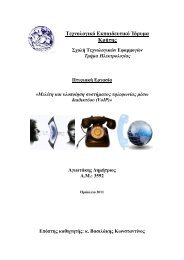Ψηφιακό Τεκμήριο
Ψηφιακό Τεκμήριο
Ψηφιακό Τεκμήριο
You also want an ePaper? Increase the reach of your titles
YUMPU automatically turns print PDFs into web optimized ePapers that Google loves.
8.1.9 Router Security Policy 39<br />
Created by or for the SANS Institute. Feel free to modify or use for your<br />
organization. If you have a policy to contribute, please send e-mail to<br />
stephen@sans.edu<br />
1.0 Purpose<br />
This document describes a required minimal security configuration for all routers and<br />
switches connecting to a production network or used in a production capacity at or on<br />
behalf of .<br />
2.0 Scope<br />
All routers and switches connected to production networks are<br />
affected. Routers and switches within internal, secured labs are not affected. Routers<br />
and switches within DMZ areas fall under the Internet DMZ Equipment Policy.<br />
3.0 Policy<br />
Every router must meet the following configuration standards:<br />
1. No local user accounts are configured on the router. Routers must use<br />
TACACS+ for all user authentication.<br />
2. The enable password on the router must be kept in a secure encrypted form.<br />
The router must have the enable password set to the current production router<br />
password from the router's support organization.<br />
3. Disallow the following:<br />
a. IP directed broadcasts<br />
b. Incoming packets at the router sourced with invalid addresses such as<br />
RFC1918 address<br />
c. TCP small services<br />
d. UDP small services<br />
e. All source routing<br />
f. All web services running on router<br />
5. Use corporate standardized SNMP community strings.<br />
6. Access rules are to be added as business needs arise.<br />
7. The router must be included in the corporate enterprise management system<br />
with a designated point of contact.<br />
8. Each router must have the following statement posted in clear view:<br />
"UNAUTHORIZED ACCESS TO THIS NETWORK DEVICE IS<br />
PROHIBITED. You must have explicit permission to access or configure this<br />
device. All activities performed on this device may be logged, and violations<br />
of this policy may result in disciplinary action, and may be reported to law<br />
enforcement. There is no right to privacy on this device."<br />
9. Telnet may never be used across any network to manage a router, unless there<br />
is a secure tunnel protecting the entire communication path. SSH is the<br />
preferred management protocol.<br />
39 http://www.sans.org/resources/policies/Router_Security_Policy.pdf<br />
156

















